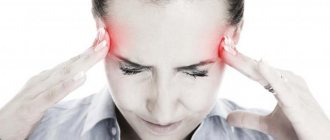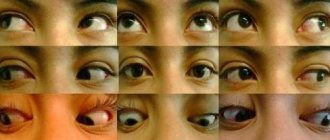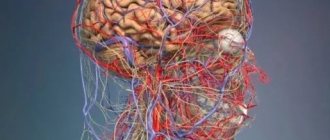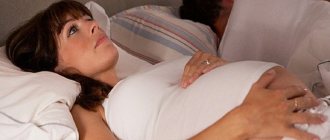Restless legs syndrome treatment with folk remedies
Traditional medicine also offers its own ways to alleviate the condition of RLS. These tips are easy to follow and can be used in parallel with drug treatment.
- When you feel an attack “approaching”, you need to twitch your legs a little - this is the first means to prevent “dancing”. You can just walk around the room or take a 30-minute walk outside. The most important thing is that you should not lie down at the first sign of an attack - move.
- During the day (advice to everyone, by the way), change your body position more often - do not sit on a chair for the entire 8 hours (even if you have a sedentary job). If you really can’t get up often, put pillows and bolsters under your feet, place a small stool and move your legs back and forth.
- As soon as you feel an attack starting, pour cold water over your feet.
- Buy a vibrating massager and massage your legs with it before going to bed - this will relax your muscles and stop an attack of RLS.
- Sleep in cotton socks and silk pajamas.
- Don't eat a big meal at night. It is better to have dinner with a glass of kefir or salad.
- Eat as many foods as possible that contain iron, such as apples. Don't give up other fruits either.
- Avoid alcohol - it will stimulate the nervous system and, as a result, provoke attacks.
- Stop smoking, as nicotine is the main trigger of symptoms. Patients are often surprised that as soon as they quit smoking, Willis disease also left them.
- Try to rest as much as possible and not become overtired.
- Instead of tea, drink decoctions of soothing herbs: valerian, St. John's wort, motherwort, mint.
Restless legs syndrome: alternative treatment
- Learn to breathe properly and relax - this will allow you to relax and, as a result, prevent an attack of RLS. The process looks like this: take a deep breath, throw all your problems and worries away, calm down, feel like your legs are filled with lead and you can’t move them.
- Rub your feet or entire legs up to your ankles with freshly squeezed lemon juice. You can make foot baths with lemon.
- Talk to your doctor about taking a multivitamin complex - this is not only very good for your health, but also a real chance to prevent the occurrence of RLS attacks.
- Take ¼ aspirin a day - this is a good blood thinner, which will help, if not completely eliminate, then at least reduce attacks of RLS.
- Make yourself a rule - every day you should eat two apples.
- At night, rub your feet with peppermint oil. Rub the skin until it turns red and a slight tingling sensation appears.
- Get yourself a hobby - in autumn, doing what you love often helps you cope with various ailments (even without taking medications).
- Remember - your feet should always be warm. If your feet often get cold, this can provoke an attack, and even complications will begin.
Remember! You should not self-medicate, especially if you are not sure of your diagnosis! Consult a doctor who can confirm or refute your suspicions of restless legs syndrome, and also recommend how to cope with the pain. Don't forget that without specific treatment, restless leg syndrome often “hides” under other serious illnesses, such as Parkinson's disease, diabetes or kidney disease.
Treatment of pathology, give preference to traditional recommendations
If Ekbom syndrome is detected in a pregnant woman, it is advisable to treat without the use of medications
The doctor takes into account that the pathology occurs due to a lack of vitamins, so he prescribes dietary supplements and vitamin-mineral complexes containing magnesium, folic acid, iron and special supplements for people suffering from this syndrome. The use of the above drugs by pregnant women is possible if women strictly adhere to the recommended dosages
The reliability, effectiveness and efficiency of the listed medications have not been confirmed by scientific evidence. Before taking medications, a pregnant woman should consult her doctor.
If RLS does not develop against the background of a concomitant underlying disease, you can cope with it yourself, at home. There are a number of alternative and harmless therapeutic methods to help relieve pain from RLS. To achieve a positive result, a pregnant woman is recommended to do the following.
- Physical exercise. Squats, stretching, extension and flexion of the lower extremities, and walking will help overcome night pain in the legs. Perform a set of exercises before bed, do not overexert yourself. Remember - excessive zeal will have the opposite effect, and the discomfort during night sleep will worsen.
- Physiotherapeutic procedures and massages. The effect of heat caused by a rush of blood to the massaged muscles will have a positive effect on the condition of joints and bones and will enhance metabolism.
- Contrast shower, with alternating hot and cold water, followed by rubbing.
- Avoiding overvoltage. Go to bed before you feel very tired.
- Dieting. Eliminate sugary foods, chocolate, cocoa, Coca-Cola and highly caffeinated drinks from your diet.
- Choose the right sleepwear made from cotton fabric or natural silk.
- Daily ventilation of the bedroom, maintaining a normal microclimate in it. There should be no extraneous sounds or loud noise in the room where you sleep. Reduce the air temperature in it so that it is slightly cool.
- Complement the main treatment with meditation and yoga exercises. Learn to properly relax your body using simple breathing techniques.
- Use peppermint oil to rub your feet (the aroma of mint soothes and helps get rid of excess tension, and a light massage relieves pain).
- Avoid stress and depression.
- Swimming more often in a pool or open water (in summer).
- Increase the number of mental loads.
- There are more vitamins and microelements, of which many are found in fresh fruits, vegetables and pharmaceutical multivitamin complexes.
- Eat at least 2 apples a day (they contain a lot of vitamins and iron).
- Spend more time on your favorite activities and hobbies.
- Drink safe medications with a calming effect (for example, a decoction of motherwort or St. John's wort, valerian tablets).
Women carrying a baby and suffering from restless legs syndrome are trying to find effective and safe ways to combat the disease. Sometimes they manage to come up with completely unusual options.
For example:
- the pain from RLS goes away after eating bananas;
- nagging pain in the calves of the legs disappears without a trace after rubbing the “Star” balm into the skin;
- acupuncture;
- if a pregnant woman is looking for an effective method to get rid of leg pain, she needs to try changing her sleeping position;
- a piece of soap under the sheet;
- an exercise in which the legs need to be raised from a lying position and held on weight for 15 minutes;
- taking a hot bath with sea salt;
- lubricating ankles and heels with menthol-based ointment.
Some pregnant patients cannot manage Ekbom's syndrome with medications, exercise, or massage. Desperate, they resort to the help of a psychiatrist, which also gives a good effect.
The individual characteristics of a pregnant patient’s body may affect the effectiveness of the proposed methods. If you can’t overcome the disease, choose other options through experimentation, focusing on your own preferences and feelings. The chosen method must calm you down and set you up for sleep.
Is the fetus in danger?
With restless legs syndrome, only the mother feels discomfort; there is no threat to the unborn baby. But if the syndrome is only a sign of another dangerous disease, immediate consultation with a doctor is necessary.
Due to constant movement, moving the legs to a comfortable position, impulses to calm down RLS by walking, a pregnant woman’s risk of developing a depressive state, apathy, and she experiences sleepless nights increases. RLS does not bode well for a person’s overall well-being.
And in an “interesting situation,” the mother’s excitement and tension will be transmitted to the baby, which is extremely undesirable for his well-being.
Finding out the reasons
Leg pain can appear both in late and early pregnancy.
It is possible to say exactly why a symptom occurs only after diagnosis, but there are a number of circumstances that are quite understandable, due to the changes that occur in the body during pregnancy:
Expert opinion
Over time, pain and crunching in the back and joints can lead to dire consequences - local or complete restriction of movements in the joint and spine, even to the point of disability. People, taught by bitter experience, use a natural remedy to heal joints, which is recommended by orthopedist Bubnovsky...Read more"
- Excess weight. Women who were overweight before pregnancy, as the fetus develops and grows, experience greater discomfort from adding additional kilograms than normosthenic expectant mothers. Already from the middle of the term, such women have aching legs during pregnancy, they swell in the evening and hurt.
- Shift in the center of gravity of the body in later stages. Redistribution of the load when walking causes discomfort in the lower extremities.
- Edema. After the 20th week, the load on the kidneys increases and if the drinking regime is incorrect, the pregnant woman may experience swelling. Physiological swelling, associated only with the consumption of large amounts of water, goes away on its own, in contrast to edema that occurs against the background of gestosis, a serious complication of pregnancy. With gestosis, arms and legs ache, and other alarming symptoms appear. Hospitalization and treatment in this case are necessary.
- Injuries. During pregnancy, old leg injuries, such as fractures or dislocations, can make themselves felt.
There are other causes of pain in the extremities in pregnant women: flat feet, uncomfortable shoes and tight clothing. A special place is occupied by cramps that occur at night during sleep. The symptom indicates an imbalance of potassium, calcium and iron and requires medication correction.
In addition to the reasons listed above, pain in the legs can be caused by excessive coffee consumption or too intense exercise.
First aid for leg cramps during pregnancy
The pain of leg cramps during pregnancy can be difficult to bear, but urgent measures must be taken to urgently restore blood circulation.
legs hurt during pregnancy photo First of all, you need to relieve muscle tension, this can be done by soft movements of the toe of the foot in an elevated position with the nails or by walking.
Movements should be smooth, as sharp pain will lead to an even more acute spasm.
The next action should be to warm up and relax the muscle tissue.
If it is not possible to apply a heating pad or hot compress to your legs, then firm rubbing movements along the numb muscle will help.
Top
The Medical Answer to Restless Legs Syndrome
To establish a diagnosis, pregnant women with RLS are recommended to visit a neurologist. At your appointment, tell us about your symptoms, their frequency, duration and severity.
Due to the difficulty of diagnosing the disease, an international group studying this phenomenon has identified criteria that help determine the presence or absence of the syndrome. Among them:
- the desire to move the limbs is caused by pain;
- the patient is forced to move his legs while in a horizontal or sitting position at rest;
- physical activity helps overcome pain;
- sensations occur in the evening and/or at night; during the day, the syndrome does not make itself felt or manifests itself to a small extent.
A team of researchers provides a rating scale to determine the severity of SNB. It involves the patient answering 10 questions, as a result of which the patient evaluates himself based on his feelings.
To help doctors make a diagnosis, polysomnography was invented - a scientific study to determine the functionality of the nervous system and involuntary physical activity.
To diagnose, sensors are attached to a sleeping patient and the number of leg movements during sleep is recorded, which is typical for patients with the syndrome. Based on the data obtained, the following degrees of severity are distinguished:
- light stage: 5-20 movements per hour;
- middle stage: 20-60 movements per hour;
- severe stage: 60 movements per hour or more.
The list of laboratory tests includes a general and biochemical blood test.
Pregnancy significantly reduces the list of approved medications. Based on the fact that RLS is caused by a lack of vitamins, nutritional supplements containing iron, folic acid, magnesium, as well as dietary supplements specially designed for people with Ekbom syndrome are prescribed to help expectant mothers. All these drugs are allowed for pregnant women, subject to dosage compliance.
However, there is no scientific evidence that these drugs are reliable, effective and will bring guaranteed results. Before taking any medication, you must first consult a doctor.
Symptoms of RLS and their scientific explanation
The syndrome is not synonymous with one disease - it is a set of symptoms of different physiological conditions, for example pregnancy. Science to this day finds it difficult to answer the question of what exactly is the cause of SNB. One version says that this is the result of biochemical processes in the brain due to a deficiency of substances that regulate the human motor system.
Another version claims that this is a hereditary phenomenon, occurring most often in women, middle-aged and elderly people with the first signals at 20-30 years of age. Expectant mothers are bothered by Ekbom syndrome from the 14th week until the end of pregnancy. The sensations disappear after the birth of the child, but sometimes remain for a long time.
Restless legs syndrome in pregnant women occurs at least once every 7 days, sometimes once every 3 days or more often. The exacerbation occurs in the evening and reaches its climax in the dead of night, calming down only in the morning. All night, sufferers are forced to do warm-ups to overcome the itching.
During physical activity, the degree of sensation decreases or disappears completely. But as soon as a person takes a horizontal position, everything repeats itself again. Research has shown that RLS affects 15% of people with chronic sleep disorders.
Ekbom syndrome in its acute form does not give rest even during the day: the legs hurt constantly and in any position, which pretty much poisons life and causes psycho-emotional disorders. The phenomenon of this disease is that seeking medical help does not always solve this problem due to the lack of a clinical picture. Symptoms do not appear in tests or examinations and are felt exclusively by the patient, which greatly complicates the establishment of an accurate diagnosis and cause of the disease. There are also no nervous system disorders.
Still, visiting a doctor for RLS is recommended, since the disease can occur in parallel with other diseases that are characterized by a lack of iron and an increased concentration of urea in the blood (for example, kidney failure).
Get a medical test to make sure you are not sick:
- anemia;
- diabetes mellitus;
- kidney disorders;
- thyroid dysfunction;
- varicose veins;
- Parkinson's disease.
The manifestation of Ekbom syndrome in such diseases is concomitant and refers to complex cases. If you have been diagnosed with one of the listed diseases, the disease itself is treated, not the syndrome.
Cramps in pregnant women
Why do cramps occur during pregnancy?
Quite often, the occurrence of seizures in pregnant women is associated with a violation of the content of any microelements. In the first trimester of pregnancy, this can occur as a result of toxicosis, accompanied by vomiting and loss of appetite, and in the second and third trimesters it is more often associated with the increased needs of the fetus for various nutrients and microelements due to its active growth and the formation of various structures - bones, tooth buds etc.
If seizures occur, it is necessary to examine the levels of calcium, potassium, magnesium, sodium and phosphate in the blood. Cramps during pregnancy usually develop when blood levels of calcium, potassium, magnesium and sodium are low and when sodium and phosphate levels are high. A lack of vitamin B in food can also provoke convulsive contractions.
Most often in practice we have to deal with a lack of calcium, potassium and magnesium. Typically, cramps are most severe in mid-pregnancy. This is explained by the maximum surge in fetal growth occurring in the middle of pregnancy and the associated consumption of large amounts of microelements.
Often, cramps are associated with a decrease in glucose (sugar) levels in the blood. This is especially true during pregnancy, because... Glucose is the main energy source and is actively spent not only on the needs of the pregnant woman’s body, but also on the vital activity of the fetus. With an incorrect diet, when food is taken rarely, but in large quantities, with a late, heavy dinner, a decrease in blood sugar levels at night and in the morning is possible, which can cause convulsive contractions.
Varicose veins also contribute to the occurrence of cramps in the leg muscles. The growing uterus can compress the veins in the pelvis and prevent the flow of blood from the lower extremities. And increased blood flow in the pelvis during pregnancy increases the load on the veins. If healthy veins can still cope with the increased load, then with varicose veins the blood begins to stagnate in the veins of the lower extremities and appear.
Due to deterioration of blood circulation, the nutrition of the muscle, the delivery of nutrients to it and the removal of metabolic products are disrupted. All this serves as a favorable background for the development of seizures. Smoking and drinking large amounts of drinks containing caffeine, including strong tea, contribute to the development of seizures.
When smoking, chronic oxygen deficiency develops, which also affects the condition of the muscles, causing spasms. And caffeine can cause muscle tension and dehydration, which is a favorable condition for the development of cramps.
First aid for seizures
If you experience calf muscle cramps, it is recommended to try to stretch the muscle in which the spasm has developed. Try to relax and breathe deeply. For the most common cramp in the calf muscle, you need to pull your toes towards you, then release the tension and pull again with a little more force. Repeat this movement until the muscle relaxes, but do not force the muscle to stretch.
After this, carefully, so as not to provoke a new cramp, massage the muscles from the periphery to the center, warming them up. You can walk to activate blood circulation. After this, it is recommended to lie down with your legs elevated to ensure blood flow and avoid repeated cramps. There is another way to relieve a cramp - a pin prick into the muscle cramped.
How to protect yourself from RLS
There are several rules for the treatment of restless legs syndrome, since the treatment method is used without medications. Most often, medications are not prescribed to pregnant women at all in these cases. Only for insomnia can a doctor prescribe teas based on soothing herbs or sedative medications to the patient.
So what should you do:
- It is recommended to avoid high physical activity throughout the day.
- Create favorable conditions for falling asleep, at least an hour before bedtime: ventilate the room, eliminate noise, do not sit in front of bright monitors, dim the lights.
- A good relaxing remedy would be a contrast shower or a warm bath. This will tone your legs.
- You can ask your husband to do a light foot massage, or do it yourself.
- Replace caffeinated drinks (tea, coffee) with herbal teas or milk.
- Do not drink alcoholic beverages under any circumstances. This is primarily contraindicated for the fetus.
- Prepare a pillow for your feet for their convenient location and comfort.
In case of recurrence of restless legs syndrome, it is necessary to eliminate the underlying disease. If there is a deficiency of some elements, replenish them, it could be varicose veins, in which case compression garments are prescribed. If this is due to disruption of the endocrine system, the doctor will prescribe hormonal medications.
Worth remembering! Self-medication can be dangerous to the health of the pregnant woman and her fetus. Before using any medications, consult your doctor.
Not all pregnant women are suitable for conventional control methods, but do not despair. Each organism is individual, try it and be sure to find your own method. Qualified doctors can help with this; they will definitely not leave anyone without help. But everything goes away sooner or later; there is a high probability that by the end of pregnancy the RLS will go away on its own.
Symptomatic picture
After assuming a horizontal position, the pregnant woman begins to feel tingling in her legs, burning, pressure, trembling, a feeling of numbness or crawling on the skin. And sometimes a woman feels quite intense pain, and it is even possible to develop a convulsive state.
The described clinical picture can occur in any area of the lower extremities and recur with a break of several seconds. It goes away when the pregnant woman engages in intense walking, rubbing or performing massage manipulations on the limbs.
The painful symptom complexes continue from the early evening until the morning, and at dawn they subside and completely disappear. While a pregnant woman sleeps, you may notice periodic small twitching of the legs.
This situation prevents the pregnant woman from getting proper rest and disrupts sleep. Therefore, she suffers from insomnia, and her general condition and mood deteriorate.
Therapeutic measures
In case of formation of a painful syndrome of any severity, it is recommended to consult a gynecologist. In this case, he will prescribe additional studies - assessing the level of ferretin (iron) and folic acid in the peripheral blood. If there is a deficiency of these substances in the body of a pregnant woman, the doctor will prescribe appropriate medications; they will improve the general condition of the pregnancy and prevent the development of pathological processes in the fetus.
And if the content of these substances is within normal limits, it should be assumed that RLS develops as a result of hormonal changes and hemostagnation in the legs. In this case, unfortunately, medications do not normalize the pregnant woman’s condition; it is recommended to use proven measures, which are also harmless to the unborn child.
- Sleeping with an open window during the warm season or in a sufficiently ventilated room. The latter must be done before the pregnant woman falls asleep in inclement weather.
- Changing sleep and wakefulness patterns. This will facilitate the process of falling asleep without waiting for the development of discomfort in the lower extremities, or, conversely, after the discomfort disappears.
- Moderate physical activity during the daytime. It is necessary to take long, slow walks, always without getting tired, in order to avoid increasing the manifestations of restless legs.
- Massage of the lower extremities before falling asleep, which will also help prevent the development of motor discomfort.
- Foot baths with cold/hot water. Such procedures are performed only after consultation with a gynecologist.
- Eliminate cocoa, coffee, and chocolate from your diet, since the caffeine contained in these products can cause an uncomfortable feeling.
- The consumption of alcohol, as a provocateur of the development of the syndrome and abnormal fetal development, is strictly prohibited.
Sensorimotor disorders are also a temporary phenomenon, like pregnancy itself. With delivery, after about a month from this point, the uncomfortable sensory-motor sensations will spontaneously disappear.
Diagnostics
As with any illness, this pathology must be carefully analyzed before an accurate diagnosis can be made.
Stages of diagnostic measures include:
- a thorough analysis of the symptomatic picture, hereditary history is assessed;
- a neurologist visually and somatically examines the patient;
- a blood test is performed for biochemistry;
- the ferritin content of blood serum is examined;
- An electroneuromyographic study is performed;
- perform polysomnography.
During the day when the patient comes to the doctor, the pathology hardly manifests itself. But according to complaints, this syndrome is often mistaken for articular or varicose pathology. That is why a polysomnographic examination is important, in which sensors are attached to the patient, collecting data on the functioning of the nervous system and involuntary movements.
For additional information about concomitant pathologies, you should consult a therapist or endocrinologist.
What does he recommend?
traditional medicine
Treatment with folk remedies gives positive results.
Massage using laurel oil. Recipe: take 30 g of bay leaf, pour half a glass of vegetable oil over them. When the oil infuses and thickens, you can rub your feet with massage movements.
Rubbing with concentrated tincture of golden mustache. Recipe: take 15-25 joints of the plant, fill them with half a liter of vodka and leave to infuse for 2 weeks in a dark, dry place. You can rub your feet with the tincture or make compresses or lotions to problem areas.
Drinking tea with linden and lemon balm is a good replacement for sleeping pills and promotes sound sleep.
Drinking hawthorn infusion helps relieve pain during cramps. The tincture is sold in pharmacies, but you can prepare it yourself: just pour a glass of boiling water over a spoonful of flowers and leave for 2 hours.
Rub with apple cider vinegar. Regular food vinegar will do. They say that if you smear apple cider vinegar on your feet, legs and ankles at night, then for that night you can forget about leg twitching in your sleep. Some people also recommend using lemon juice.
Foot baths with the addition of herbs help a lot. Pour 50 grams of a mixture of various herbs into 0.5 liters of boiling water and leave for 2 hours. The tincture is added to the foot bath. It is recommended to use nettle, sage, oregano, currants, and valerian.
Wine vinegar helps cope with pain in the lower extremities - just rub your legs with it before bed and you will fall asleep, forgetting about the syndrome.
Traditional medicine also advises rubbing the skin with mint oil, eating 2 apples every day, and taking 1⁄4 tablets of aspirin every day to thin the blood. To avoid symptoms, be sure to keep your feet warm.
How to relieve the condition
Here are some simple preventative recommendations:
- Watch your weight. It is not recommended to overeat and drink too much liquid. Carbonated water should be excluded from the diet, and foods rich in microelements and vitamins should be included in the diet.
- During pregnancy, it is important to maintain good posture. Also wear comfortable shoes with low heels; avoid high heels. You shouldn't wear shoes without heels either, as this can lead to flat feet.
- Use special bandages and corsets for pregnant women.
- To prevent vein pain, it is recommended to take walks in the fresh air more often, but do not overload your legs with walking. Swimming will be useful.
- Don't stay in the sun for long periods of time.
- Do gymnastics for pregnant women. Exercise therapy will help get rid of pain.
- Sleep on your left side if you have high blood pressure, as this position helps reduce it. If possible, do not overexert yourself physically.
- To relieve swelling, it is useful to lie down with the foot end of the bed raised.
- For varicose veins, wear special corrective underwear. Its size is determined only by a doctor.
- Walk barefoot on clean sand or wet grass.
- Baths are not recommended. The best option during pregnancy is a contrast shower. It will strengthen the walls of blood vessels and reduce pain in the legs.
- If you have pain in your feet, then place your feet in a basin of cold water and lift them one at a time. You can also pour cold water over your calves and ankles. Then you should wipe your feet dry.
Adequate nutrition, adherence to preventive advice to prevent pain in the legs, timely therapy will help a woman easily endure pregnancy and give birth to a healthy child.
How to forget about back and joint pain?
We all know what pain and discomfort are. Arthrosis, arthritis, osteochondrosis and back pain seriously spoil life, limiting normal activities - it is impossible to raise an arm, step on a leg, or get out of bed.
These problems begin to manifest themselves especially strongly after 45 years. When you are face to face with physical weakness, panic sets in and it is hellishly unpleasant. But there is no need to be afraid of this - you need to act! Which product should be used and why – says leading orthopedic surgeon Sergei Bubnovsky...Read more >>>
Author:
— Medical journalist. First category nurse in the department of traumatology and orthopedics
Enter your email to receive the free book “7 Simple Steps to a Healthy Spine”
You may be interested in the following FREE materials from physical therapy and sports medicine doctor Alexandra Bonina:
- Mini-course “5 proven principles of treatment of spinal osteochondrosis”
- Book “17 recipes for delicious and inexpensive dishes for the health of the spine and joints”
- Book “7 Harmful Morning Exercises You Should Avoid”








